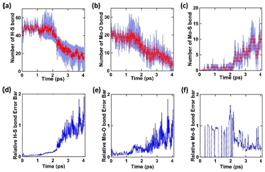 Multiobjective genetic training and uncertainty quantification of reactive force fields(多目标遗传训练和反应力场的不确定度量化)
Multiobjective genetic training and uncertainty quantification of reactive force fields(多目标遗传训练和反应力场的不确定度量化)
Ankit Mishra, Sungwook Hong, Pankaj Rajak, Chunyang Sheng, Ken-ichi Nomura, Rajiv K. Kalia, Aiichiro Nakano & Priya Vashishta
npj Computational Materials 4:42 (2018)
doi:s41524-018-0098-3
Published online:02 August 2018
Abstract| Full Text | PDF OPEN
摘要:ReaxFF反应力场方法极大地扩展了反应分子动力学模拟在各种材料性质和过程中的适用性。其参数一般都经过了大量的训练,以适用于一组预定义的量子力学数据,但在应用于复杂化学反应时,仍然无法准确地描述好我们感兴趣的量。本研究提出了一种基于多目标遗传算法的动态方法,用于训练ReaxFF的参数和量化我们感兴趣的物理量的不确定度。ReaxFF参数的训练是通过直接拟合反应分子动力学轨迹与量子分子动力学轨迹的动力学过程来进行的,在这个过程中,多个感兴趣量的Pareto最优前沿为不确定度的量化提供了一系列ReaxFF模型。我们的原位多目标遗传算法工作流程利用进程间通信消除了文件I/O瓶颈,实现了可扩展性。高温硫化是化学气相沉积合成MoS2层的必要反应步骤,我们将原位多目标遗传算法工作流程应用于H2S前驱体对MoO3的高温硫化。这项研究为远离平衡的化学过程提出了一种新的反应分子动力学模拟方法,该方法在提供误差范围的同时定量再现了量子分子动力学的模拟。
Abstract:The ReaxFF reactive force-field approach has significantly extended the applicability of reactive molecular dynamics simulations to a wide range of material properties and processes.ReaxFF parameters are commonly trained to fit a predefined set of quantum-mechanical data, but it remains uncertain how accurately the quantities of interest are described when applied to complex chemical reactions.Here, we present a dynamic approach based on multiobjective genetic algorithm for the training of ReaxFF parameters and uncertainty quantification of simulated quantities of interest.ReaxFF parameters are trained by directly fitting reactive molecular dynamics trajectories against quantum molecular dynamics trajectories ReaxFF on the fly,where the Pareto optimal front for the multiple quantities of interest provides an ensemble of ReaxFF models for uncertainty quantification.Our in situ multiobjective genetic algorithm workflow achieves scalability by eliminating the file I/O bottleneck using interprocess communications.The in situ multiobjective genetic algorithm workflow has been applied to high-temperature sulfidation of MoO3 by H2S precursor, which is an essential reaction step for chemical vapor deposition synthesis of MoS2layers.Our work suggests a new reactive molecular dynamics simulation approach for far-from-equilibrium chemical processes, which quantitatively reproduces quantum molecular dynamics simulations while providing error bars.
Editorial Summary
Molecular dynamics: multi-objective genetic algorithms for training and uncertainty quantification(分子动力学:用于训练和量化不确定度的多目标遗传算法)
多目标遗传算法允许训练力场参数和量化不确定度,同时对分子动力学代码的修改是最小的。来自美国南加利福尼亚大学的中野爱一郎教授领导的团队,使用了一种基于反应分子动力学(RMD)模拟的算法来训练反应力场参数和对模拟量进行了不确定性的量化。他们以化学气相沉积MoS2单层的合成为例,对量子分子动力学(QMD)模拟进行了力场参数的训练。从一个128原子MoO3-H2S系统出发,通过估算在QMD模拟过程中H-S、Mo-O和Mo-S键的数量作为时间的函数来研究反应动力学。通过与RMD模拟结果的比较,他们发现RMD可以在误差范围内定量地再现QMD。
Multi-objective genetic algorithms allow training and uncertainty quantification of force-field parameters with minimal modifications of molecular dynamics codes. A team led by Aiichiro Nakano at University of Southern California used an algorithm based on reactive molecular dynamics (RMD) simulations for the training of reactive force-field parameters and uncertainty quantification of simulated quantities of interest.Chemical vapor deposition synthesis of MoS2 monolayer was set as a specific example, and force-field parameters were trained against quantum molecular dynamics (QMD) simulations.Starting from a 128-atom MoO3–H2S system, the reaction dynamics were investigated by estimating the numbers of H–S, Mo–O, and Mo–S bonds as a function of time during the QMD simulations.By comparing these quantities of interest with those obtained in the RMD simulations, it was found that RMD can quantitatively reproduce QMD within an error bar.


 沪公网安备 31010502006565号
沪公网安备 31010502006565号